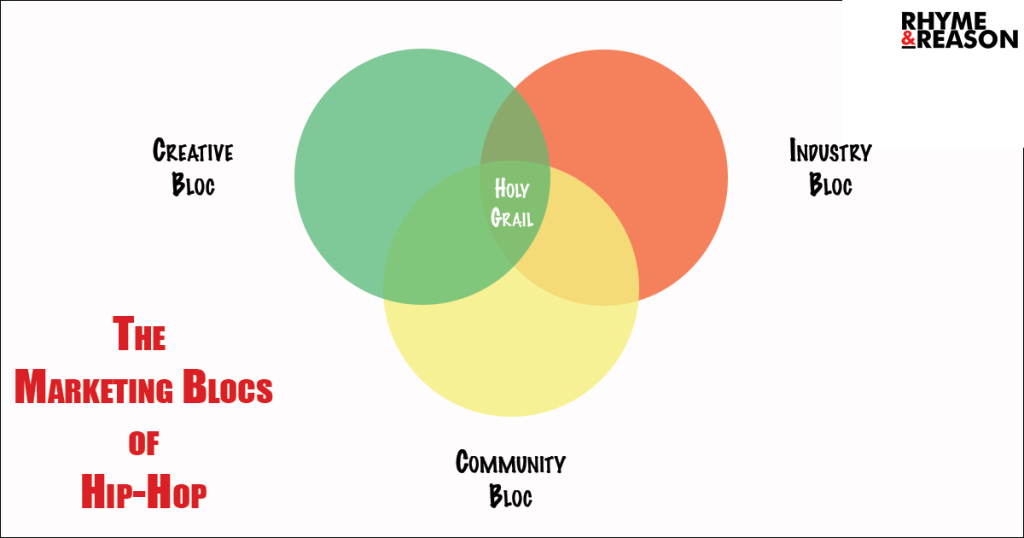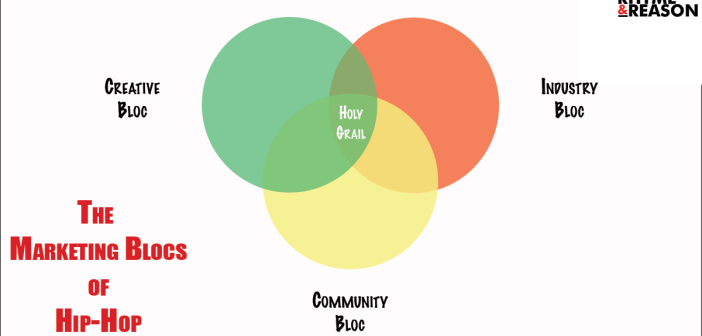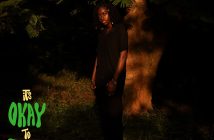A working theory has bothered me for a while. It all started while I tried to make sense of all the data our platforms continue to gather over the years and our relationship with it. I was looking to quantify the ecosystem’s exact value. This helps to make sense of potential and projection values for shortly and long term.
There are 3 blocs involved in hip-hop marketing; the Community, the Creative, and the Industry. Each of these blocs need a perceived value for economic activities to happen between them. Although the Community Bloc determines the frequency and rate of the economic activities within these relationships.
Stay with me
The Creative Bloc
The Creative Bloc, for the sake of this write-up, will be defined as the representatives of the Community Bloc. The individuals in this bloc were born, raised on different streets, neighbourhoods, or States. Their crafts, services, or art represent their past, present, and possibly future lives and experiences.
This bloc includes artists, Producers, Dancers, Artists, Writers, DJs, Sound Engineers, Fashion Designers, etc. They are creative individuals who bring ideas to life.
By engaging their ever-growing community through representation and consistency, they increase economic activities and the perceived value of their artistry.
The Industry Bloc
The Industry Bloc includes the goods and services sector. From physical goods to services that serve the Creative and, or Community Blocs. A decision by this bloc can begin, increase, decrease, or end economic activities in either or both blocs. And just like the Creative Bloc, the Community Bloc also determines its value and lifecycle.
The Community Bloc
This is the oga patapata of them all. They are the end users and consumers of products/services from the Creative and the Industry Blocs. They determine the true value of both blocs, regardless financial projections. If the Community Bloc cancels you, just go home and call it a day.
In Hip-hop, this bloc hates to be told what to do. They set trends, and determine what is cool or not, despite the benefits or functionality of the products/services by the other blocs.
The Bloc Relationships
Now that definitions are out of the way, I’ll explain the relationships between these blocs and how they affect buying decisions, perceived value, and mutual trust.

The Creative-Industry Bloc Relationship
Jordan-Nike
Everyone who had seen Michael Jordan play basketball up until being drafted by the Chicago Bulls loved him, thus, he had built his community. Nike needed his community because he would be seen by the world playing basketball and they would love him. If he’s doing that wearing their shoes, they will extend their love for him to those shoes. Air Jordan was born with a signing fee, percentage of shoe sales, and Nike stocks. Jordan grew his Community Bloc relationship to increase economic activities between all 3 blocs.
Creative plays good basketball; the community pays the industry premium to watch creative play and buy products with or associated with his name or image, increasing his economic value; the industry pays the creative a higher salary; the creative charges the industry a premium for access to his community.
Ye-Adidas
Kanye West is a multi-platinum recording-selling, multiple Grammy Award-winning artiste (hip-hop artiste and producer), and a billionaire with a global community. Adidas is a (sports) fashion member of the Industry Bloc that is ingrained in the DNA of the hip-hop communities–their sneakers, especially. Their relationship advanced the Yeezy fashion brand which ultimately made Kanye a billionaire. Following a series of online rants, labelled antisemitic, Adidas ended its contract with Ye in October 2022. This unexpectedly left the company with over 1.2b Euros worth of Yeezy products in inventory without the creator/creative to back it.
The company claimed to have retrieved 814m Euros from Yeezy releases in 2023 and donated some of the proceeds to charity. The remaining may be sold at cost price later this year after posting a $63m net loss due to lower sales of Yeezy clothing. Kanye on the other hand released Yeezy–Gap inventory in Feb. 2024 without Gap’s permission; selling every item–hoodies, shirts, pods, etc.– for $20 with a Super Bowl ad to promote it. He made $19.3m 24 hours later from over 200k orders.
Industry drops creative; community determined the reduced value of the product and pay less; community shows support to creative on new merchandise and increases economic activities in his direction; Creative & Industry survives a bad break-up because of their strong connections with the Community.
Dylan Mulvaney-Bud Light
Dylan Mulvaney is a transgender woman signed by its parent company AB InBev to promote Bud Light. On April 1, Dylan promoted Bud Light on their page, mentioning a US$15,000 promotion for Bud Light consumers. Conservative members of the Creative and Community Blocs reacted by citing the industry’s involvement in “political” issues leading to a boycott. The LGTBQ+ members of the Creative and Community Blocs joined the boycott after the parent company attempted to distance itself from Mulvaney. This led to a $23b stock valuation (-20%) loss in 60 days, a 17% decline in overall sales, a 28% sales decline of Bud Light, 16% in Budweiser sales, 12% in Busch, and 10% in Michelob Ultra.
Industry partners with creative connected to a sensitive public debate; Creatives and Community reacts and reduces economic activities with Industry; Industry backtracks on the partnership to end decline in economic activities; another section of Creative and Community joins original reaction and further reduces economic activities with industry.
The authenticity of the Creative-Industry Bloc relationship relies on the strength of its relationship with the Community Bloc. Industries should remain neutral in sensitive political issues because picking a side might harm their ongoing economic activities. Creatives may survive picking a side in sensitive “political issues,” because part of the community agrees with them; increasing economic activities towards the creative, no matter their numbers.
Therefore, creatives should focus on growing their communities. They are the ultimate determinant of their value.
The Industry-Community Bloc Relationship
In the 2000s, as secondary school students in Nigeria (Day or Boarding) owning brands like JanSport backpacks, Trekkers or Teva sandals, Birken Stocks, or Timberland clothing signified you as a “Cool” kid or person. As primary school pupils in the 90s, it was all about owning Bata & Famad shoes (Container), computer socks, and a wristwatch (any kind would do) to be the definition of “cool.”
Timberland
The only brand I know via hip-hop culture from the list above was Timberland. Timberland went from being safety boots to urban fashion accessories, because of its “cool” portrayal by the Community Bloc. Its hip-hop community relationship began when New York hustlers (drug dealers) with money went uptown to splurge on uptown designer gear. By the time hip-hop went mainstream in the 90s, creatives who grew out of these communities made it part of their style, thus, its popularity grew with the popularity of hip-hop.
The CEO would later give an interview stating that the black/hip-hop community only contributed 5% of total sales, which news publications claimed was a bald-faced lie. That Timberland was regarded as urban fashion shoes (that made you instantly cool) and not safety boots in black/hip-hop Community Bloc. They claimed the owners believed associating the brand with the black/hip-hop Community Bloc would diminish its value. This led to a decline in overall sales and the brand atoned for this “corporate racism” by investing heavily in the black/hip-hop Community via partnerships with Creative Blocs and inner city projects in the Community Blocs–creation of suede and fur-ankled Timberlands. It went on to become a billion-dollar brand.
Members of the Community Bloc appreciate Industry and create economic activities; more members of the Community Bloc are influenced and make it a lifestyle, hence, increasing economic activity with Industry; Industry denies knowledge of healthy relationship with the Community Bloc; Community Bloc reduces economic activities with industry; Industry repairs relationship by investing in the Community’s economic activities; Community appreciates Industry’s atonement and resumes economic activity.
Nike/Adidas/Reebok
Nike’s relationship with Michael Jordan began its relationship with the black/hip-hop Community Bloc. The more success Jordan garnered, the more popular the Air Jordans and other Nike items became in the community. People got robbed and killed for their Nike shoes (Air Force 1s, Air Max, Air Jordans). Nike doubled down on strengthening their community relationships by investing in more Creatives even before they stood out from the Community Bloc–athletes (high school to professional level), artistes (emerging to legend), community projects etc. They also invested in the community by making products for the communities–Durags, Bandanas, Shoe lines, etc. Nike, Adidas, and Reebok are household names in the black/hip-hop Community Bloc. They are badges of “Cool” if you are spotted in one.
Industry created a Community through the Creative bloc; Industry strengthened Community relationships to increase economic activities
We see the Community Bloc holding the leverage in this relationship. Yes, the Industry Bloc has the capital, but the Community Bloc determines the P&L. The degree of this P&L lies in how actively engaged the Industry is with the Community; other times, if the product is an everyday product of high-quality and moderate pricing, the Industry may as well remain passive while the Community passively increases economic activities by making it a household name.
Remember, being actively engaged can get you in trouble if you are on the wrong side of political/religious/gender/race/ethnicity-related issues that are very controversial.
The Creative-Community Bloc Relationship
This relationship is the bedrock of the Hip-Hop culture and lifestyle. This relationship makes it possible for individuals to be successful by just being themselves or doing what they enjoy; Content creators in thousands of niches; from food to comedy, animation, art, education, finance, technology, music, movies, reality TV, news, paranormal, history, military, martial arts, health, etc., can create a means of livelihood and pay bills by just putting in the work and sharing their results with the Community Bloc; online and offline.
The Elites
Individuals who stood out from their peers because of hard work, consistency, and continuous development of their skills. You find these individuals at the top (past and present) of their profession; Michael Jordan, Usain Bolt, Serena Williams, Cristiano Ronaldo, Eminem, Nicki Minaj, Dr. Dre, Timbaland, Pharrell Williams, Tunde Onakoya, Hilda Baci, Olamide, 2Baba, etc.
They were able to create a future/path for their colleagues with their platforms, directly or indirectly.
Brymo
A talented singer was introduced to the Community Bloc with his hook on a smashing hit record, Oleku by Ice Prince in 2011. After his short stint with Chocolate City, Brymo pursued a career by building a core audience by honing his skills one release at a time; with some great features with mainstream attention, occasionally. His albums can be regarded as Cult Classics, and his shows were genuinely sold out from small and moderately sized venues. Folks saved up to watch Brymo perform, with their spouses and lovers.
Brymo, with a Community Bloc of different ethnicities, races, religious beliefs, and philosophies of life, decided it was in his best interest to put his professional cap aside and air his personal beliefs on ethnicity via his social media platform, X (Twitter). This was in the middle of an ongoing religious and ethnicity-based presidential and gubernatorial (Lagos State) campaign of the ruling party, APC. Supporting a controversial candidate based on only ethnicity did not get him in trouble. The Carpenter’s Son decided to toy around with career suicide by sharing his disgust for the opposition and his ethnicity.
New creative emerges with talent and consistency; Community acknowledges this and follows him everywhere; approaching Legendary status creative fucks around; Community still making him Find Out by decreased economic activities.
Olamide
He emerged at a critical time for indigenous hip-hop artistes in the Community. Lord of Ajasa’s era was at an end, 9ice was doing well as a commercial indigenous hip-hop artiste, Alaga was still figuring out his brand/path, and the “Voice of the Street” seat remained empty with the passing of DaGrin. The moment Eni Duro dropped, Olamide remained on the airwaves consistently for a decade. He had at least 4 hit songs each year; both his and featured. Somewhere along the line, he introduced Lil’ Kesh, Adekunle Gold, Chinko Ekun, and others via his platform.
Lil’Kesh was an instant hit and went on to have what I’ll tag as the most successful debut hip-hop/rap album in Nigeria. He had Maybach Music‘s Wale on a remix that made it to his debut album. The original song was released less than a year prior. Adekunle Gold was also a smashing hit in the singing section with his fusion of afro-folk-RnB-Soul debut album, Gold. Less than a decade later, he does the same with Fireboy Dml and Asake, who both had a great debut project run.
Baddo has put several emerging artistes on by giving them a verse on their song, putting them on his album, or in ways he stands to gain nothing from. The Community loves him and they will ride or die for him. Other creatives in this category include Don Jazzy, Show Dem Camp, Zlatan, M.I, A-Q etc.
New creative emerges with talent and consistency; the Community acknowledges this and follows him everywhere; Superstar Creative introduces new emerging artistes to the Community; the Community’s respect for creative grows and he becomes a leader to them–his wish, their command; Economic activities increase toward whatever they put out or endorse.
By being passionate and professional, a creative can have a Community Bloc that will support them until the end of time. The Community can also take this away when they eventually get to meet their heroes; mere humans that fall to the same temptations regular people endure.
Lastly, the Community Bloc is a sucker for a David v Goliath journey or story. The more wins you bag along the way from emerging to legendary status, the closer they get to you, invite you into their houses, let you have the remote control, and meet their kids who then carry a torch for you even if they were not alive to witness any part of your professional career.
The Creative-Community-Industry (The Marketing Trifecta)
A partnership with a creative and the industry with a healthy amount of community support is the Holy Grail of (Hip-Hop) Marketing.
Jordan–Nike, Dr. Dre–Apple, Asa–GTB, and Reminisce–Orijin are examples of Holy Grail partnerships that were successful because the market agreed with these partnerships and increased economic activities towards the products or services promoted.
Conclusion
So far so good, we’ve explored different interactions of the Trifecta Blocs relationships and how it affects economic activities and values.
Our MO for our B2B and B2C clients is to engage the hip-hop communities to obtain high conversion rate at every marketing level with client-specific/customised content, digital and experiential marketing strategies.
Over time, we will explore present, past, and potential partnerships that will be beneficial for the Blocs involved–through experience and hypothesis.
Sign-up for our Newsletter.
What do you think about the Trifecta of Hip-Hop Marketing?
Let’s chat.




